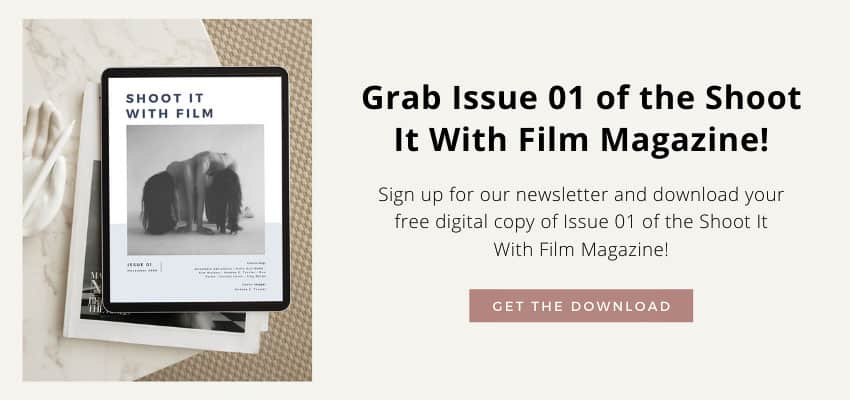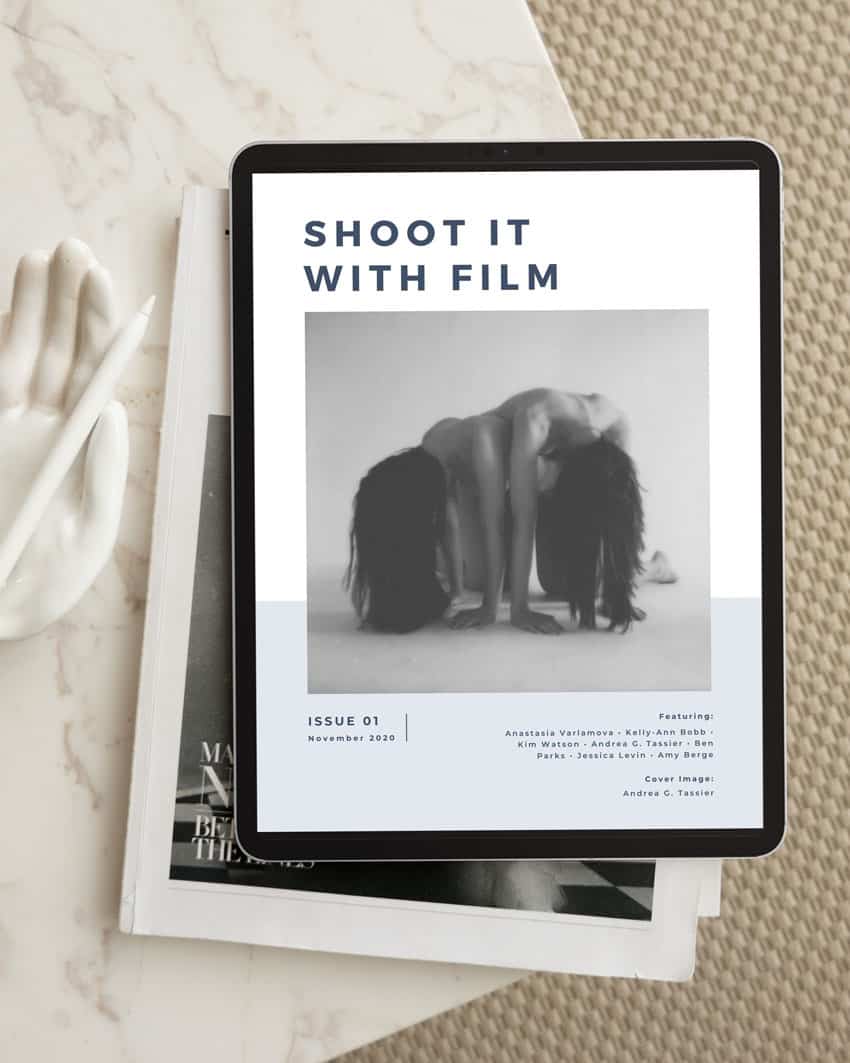
Written by David Rose
Slide films are among the most beautiful and simultaneously challenging film stocks to shoot. They are also known as positive or color reversal films due to how the final processed image is a realistic rendition of the scene and not the murky orange/brown image that color negative films produce.
One of the coolest aspects of slide film (and something all film shooters should experience at some point) is holding the film frame in your hand – when viewed on a light table or held up to the light, it looks like a tiny window into a whole vivid world.




Depending on your age, you may remember family slideshows as a kid where everyone would gather around an old-school projector, dim the lights, and slowly advance through a carousel of images from a recent trip with a satisfying “click ca-thunk” between every picture.
These slideshows were made possible with slide film and by projecting light through the transparencies or slides onto a blank screen.
A Note about Slide Film
If at this point you’re ready to pick up some slide film and start shooting, then, I also need to give you this warning: These films are some of the hardest to shoot out of the analog lineup.
Most B&W films have a generous ~5-stop exposure latitude, and most color films have a ~3 stop exposure latitude, which means that you can miss the mark and still come away with a great image.
Slide films on the other hand have maybeee 1.5 stops (on a good day), so you have to meter almost perfectly to avoid having your shots looks like these disappointments:



Some of the most frustrating experiences I’ve had shooting film are from my forays into color reversal film.
Nothing will make you more miserable than getting your shots back and realizing they were either washed out with strange color shifts (overexposed), or a dim shadowy mess (underexposed), but if I’ve learned anything from Calvin & Hobbes it’s that being miserable builds character:


Types of Slide Film
Here are the films we will be comparing in this article – all of which are still in production at the time of publication:
- Fujifilm
- Fujichrome Velvia 50 (find on Amazon or at Adorama)
- Fujichrome Velvia 100 (find on Amazon or at Adorama)
- Provia 100F (find on Amazon or at Adorama)
- Kodak
- Ektachrome 100 (find on Amazon or at Adorama)
Standard disclaimer: All example images are shown as originally scanned by the lab, with no post-processing, for objectivity in comparison. Find me on Instagram to see additional shots and feel free to reach out with any questions!
Related: Guide To Choosing A Color Film
Fujifilm (Velvia 50, Velvia 100, Provia 100F)
Although the names sound similar, there are three different types of slide films that make up the current offering from Fujifilm, and each are distinct with their own specific strengths and weaknesses.
Fujichrome Velvia 50
Fujichrome Velvia 50 film has been a favorite of landscape photographers since it was first introduced in the 1990’s, and was one of the death knells for Kodak’s long standing and more difficult to process Kodachrome.
Being a 50 ISO film, you already know that the grain is going to be extremely fine, which makes the amount of detail you can squeeze out of Velvia 50 second to none.
This film also has vibrant color reproduction, and is the in-camera equivalent of dragging your saturation slider all the way up.
Velvia excels as a daylight landscape film, but not so much for portraits since it tends to oversaturate skin tones.
Longer exposure times are often needed when shooting around sunrise/sunset or in low light due to the slow speed of the film.
Find Velvia 50 on Amazon or at Adorama.
Velvia 50 Examples:







Fujichrome Velvia 100:
If Velvia 50 is Walt Disney, Velvia 100 is Roy Disney – the less popular version of its celebrity sibling. I’ve seen Velvia 100 attract a lot of negative comments, usually labeling it inferior in comparison to Velvia 50, but I think this reputation is undeserved and there are situations where Velvia 100 is preferrable.
While the faster ISO speed/1-stop advantage makes this a marginally more versatile film than its slower counterpart, you really have to be dead-on with the exposure as Velvia 100 has an extremely low dynamic range.
On the “positive” side (see what I did there?) it has a notable magenta cast and soft colors which can nicely render certain landscapes. My favorite use case for Velvia 100 is when the sun is either right on or below the horizon since it really draws out the naturally purple tones in these situations.
Another fun fact: The name Velvia is a portmanteau of “Velvet Media” (so named because of the velvety smooth image structure), and the edge code you see on the film strip – RVP – stands for “Reversal/Velvia/Professional series”
Find Velvia 100 on Amazon or at Adorama.
Velvia 100 Examples:








Fujichrome Provia 100F:
Provia 100F has the most accurate color reproduction I’ve seen out of any analog film. This, combined with its faster speed, makes it the more versatile choice when your scenery and light might change unexpectedly.
If you want to capture a scene almost exactly how it originally appeared then Provia 100F is the right film for you.
For the long exposure aficionados, Provia 100F has almost no reciprocity failure up to ~2 minutes (according to Fujifilm), so this is a great choice for when you’ll be shooting from a tripod and really letting the film draw in as much light and color as possible.
The latest version of Provia improved on image storage and color permanence, making it a good archival film that won’t fade over time.
Find Provia 100F on Amazon or at Adorama.
Provia 100F Examples:





Kodak Ektachrome 100 (E100)
Ektachrome is perhaps one of the most legendary films of all time – if you grew up reading National Geographic magazines then chances are that you’ve already seen your fair share of Ektachrome images.
Originally developed in the early 1940’s, Ektachrome has seen many iterations over the years. This film was sadly discontinued in 2013 when interest in analog photography was waning, but Kodak later decided to resurrect it in 2018 when film started regaining popularity, and it has since been making a forceful comeback.
I’ve been shooting a lot of E100 this year, and it has quickly grown on me as one of my favorite reversal films. The color rendition is excellent, although there is a mild green cast, and the detail and resolution makes it perfect for capturing the vast landscapes that I’m inexorably drawn to.
It’s also very forgiving for a reversal film, and has more dynamic range than most slide films, which makes it great for negative shooters who want to cross over to the positive side.
Only downside to this film is that it can almost appear too “digital” in certain conditions.
Find Ektachrome 100 on Amazon or at Adorama.
Ektachrome 100 Examples:








Hope you found this guide helpful! In my opinion, trying out slide film is a must for every analog photographer.
It will stretch and grow you as a photographer, and you’ll probably end up with some beautiful photos in the process.
Thank you so much, David! David is a regular contributor here at Shoot It With Film, and you can check out his other articles here, such as his Guide to Choosing a Color Film and Ilford Black and White Film Guide.
You can also find more of David’s work on Instagram!
Leave your questions about shooting slide film below in the comments, and pick up some for yourself on Amazon here: Velvia 50, Velvia 100, Provia 100F, and Ektachrome.








Blog Comments
Mundy
April 25, 2021 at 11:45 pm
Hi David, great articvle and your comments are, in my opinion, on the money. I have used slide film for most of my photos. Kodachrome 25 and 64 where among my favorites, but no longer avaiable as you know. I am now trying several different film stocks based on your information from the article.
Thanks.
Mundy
PS: Monument Valley is timeless.
David Rose
April 29, 2021 at 12:18 am
Thanks Mundy! Glad you found the article helpful.
What I would give to shoot Kodachrome, but alas I started shooting film long after they stopped processing it… hopefully one day they will bring it back!
Bill Watts
February 10, 2023 at 10:55 am
Nice article. I have been a long time shooter of reversal film. I started out in my teens as it was cheaper to have a slide film processed than a 36 exposure print film. My go to film back then was Ektachrome 64. which tended to render a little on the cool side. I shot a couple of rolls of Kodakchrome but never liked the results and stuck with Ektachrome until I discovered Fuji Sensia. as an entry level film in 100, 200 and even 400 ISO it rocked. A little more forgiving than Ektachrome and the colours were spot on, That was followed by Sensia II finally being phased out and replaced with Astia and Provia. I still think Fuji make the best slide film, I have yet to try a roll of the new E1 Ektachrome. Velvia is my all time favourite. Processing the E-6 films is getting more difficult. I will have to switch to home processing I think. I have been successful with that so far. Medium format slides are really impressive. Long live slide film
Craig
February 12, 2023 at 10:24 am
Amazing photographs, David. Thanks for sharing.
Shalkar
February 20, 2023 at 9:31 am
I live in kazakstan. In our country, no even one place where can process color film.please tell me ,if I take photographs with reversal film where I can send my reversal film to process? Thank you.